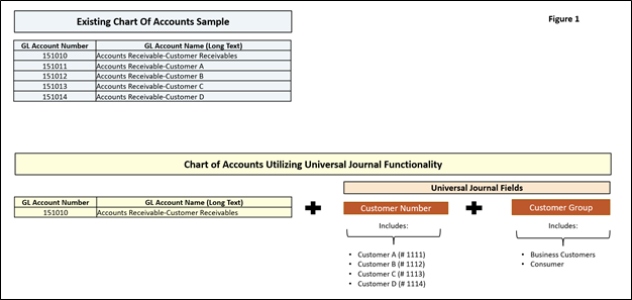Learn how to configure and implement the new Extension Ledger functionality in SAP S/4HANA Finance. Find out how to deactivate a ledger in a company code.
Key Concept
The Extension Ledger, which is only available in SAP S/4HANA Finance, helps you to save space in the database. You can use it to avoid duplication of journal entries if many business transactions are valid for the Extension Ledger and for the non-leading ledger, which already exists as a part of the SAP General Ledger. Only a few adjustments are required in the Extension Ledger for management or realignments. Deactivation of a ledger is useful if you don’t want the non-leading ledger to be valid for all the fiscal years, but instead want to set it up to be valid only to a certain point in time.
Generally ledgers provide a specific view of financial data. SAP provides only one leading ledger in every client. It is typically called the 0L ledger. This leading ledger is mainly used for the reporting of a company’s consolidated financials. It is the only ledger in an SAP system that is integrated with all the submodules and updated for all company codes. The non-leading ledger usually stores a lot of redundant data. All the entries that are posted in the leading ledger (0L) also flow to the non-leading ledgers.
With the new concept of Extension Ledgers, you can add the Extension Ledger on top of another ledger. That means you can add the Extension Ledger on top of either a leading ledger (0L) or a non-leading ledger. Note that you cannot add an Extension Ledger on top of another Extension Ledger providing different data views as needed; that is, you cannot have a Base Ledger as another Extension Ledger. Thus, the Extension Ledger does not store the data that is posted in the leading ledger. It only stores the delta entries that are posted specifically to the Extension Ledger. I describe scenarios that might require Extension Ledgers and what the benefits are of using the Extension Ledger for each scenario.
Note
Although in its configuration guidelines, SAP still refers to the Appendix Ledger, this functionality is now called the Extension Ledger. Throughout this article I use the term Extension Ledger instead of Appendix Ledger.
Examples of creating specific Extension Ledgers can include an extension 1 ledger created for posting into closed periods for restatement purposes, while the extension 2 ledger can used for adjustments for consolidation purposes only.
SAP standard solutions provide you with tools to post and view data with different views. Each Extension Ledger provides a specific view of the financial data since a ledger usually stores a lot of redundant data to other ledgers.
Consider an example of the non-leading ledger concept in the SAP General Ledger. Once a non-leading ledger is assigned to company codes, all the automated postings, including manual entries, flow to both the leading ledger and non-leading ledger. However, you can use transaction code FB50L to post to a specific ledger in the SAP New General Ledger. This transaction only posts to a specific ledger.
The system reads the data from the Extension Ledgers as shown in
Figure 1.

Figure 1
Data retrieval for the Extension Ledger
When you use Extension Ledgers, you can see advantages, such as:
- The Extension Ledger stores delta values and points to another ledger, thereby providing a flexible mechanism for adjustment and reporting.
- The Extension Ledger stores only delta values of the adjustments and while reporting it combines the Base Ledger (whichever ledger you specify in the configuration as Base Ledger it could be leading ledger [0L] or any non-leading ledger) with the values in the Extension Ledger. It is very easy to set up the Extension Ledger as it requires very minimal configuration from a system perspective.
- In SAP S/4HANA Finance all the financial entries are stored in the Universal Journal table and even the Extension Ledger entries are stored in the same table. Since the Universal Journal entry table stores just the delta entries posted to Extension ledger, it reduces the reconciliation effort for the manual entry posting specific to this Extension Ledger, unlike the non-leading ledger where every entry is posted to all the assigned ledgers to the company code including the non-leading ledger. Since the Extension Ledger is always based on the Base Ledger, all the postings made to the Base Ledger (which could be leading ledger (0L) or non-leading ledger) also apply to Extension Ledger while retrieving the balances for the SAP General Ledger.
Using Extension Ledgers provides you with the following benefits:
- The Extension Ledger stores delta values and points to another ledger, thereby providing a flexible mechanism for adjustment and reporting.
- Besides creating a master record for the Extension Ledgers, there is no need for any additional configuration.
- Reporting on the Extension Ledger always includes the data from the Base Ledger.
- Multiple Extension Ledgers can point to the same Base Ledger.
- A reduced data footprint.
- A reduced reconciliation as only manual delta postings are maintained in the Extension Ledger.
- Extension Ledgers are stored in the Universal Journal table just like the normal ledgers.
- The Extension Ledger provides different management views without touching the underlying data from the Base Ledger.
Note
As part of SAP S/4 HANA Finance, SAP has provided the concept of the Universal Journal. Universal Journal means there is only one accounting document that is a single source, and by doing this SAP has eliminated the other documents like Controlling (CO), Profitability Analysis (CO-PA), and the material ledger. In a Universal Journal only one line item table (ACDOCA) stores full details of all other applications, such as the SAP General Ledger, CO, Asset Accounting (FI-AA), CO-PA, and the material ledger. Thus, SAP has provided a single line item table as a source for all the financial data. I am not going to cover this topic, but this is just for understanding since later I am going to access this Universal Journal (ACDOCA) table to verify how data is stored while posting to the different ledgers.
For my examples, I show how to create two ledgers: one G4 as the Extension Ledger and one GZ as a non-leading or standard ledger.
Step 1. Create the Extension Ledger
In explaining how to set up the Extension Ledger, I assume that you are already familiar with the SAP General Ledger concept of ledgers and leading ledger 0L is already defined.
To set up the Extension Ledger, follow IMG menu path Financial Accounting (New) > Financial Accounting Global Settings (New) > Ledgers > Ledger > Define Settings for Journal Entry Ledger.
In the initial screen that appears (
Figure 2), click the New Entries button. The Ledger Type column has two options. One is the Standard Ledger and the other is the Extension Ledger, which is new with SAP S/4HANA Finance.

Figure 2
The initial screen to define settings for the Journal Entry Ledger
In the next screen (
Figure 3), select A Appendix Ledger from the drop-down list of options in the field under the Ledger Type column. In the field under the Ledger column, enter G4. Under Ledger Name, enter the name of the ledger (e.g., G4 Extension Ledger for GS04), and under Base Ledger, select 0L for the leading ledger.

Figure 3
Configure the Extension Ledger and assign the Base Ledger
After entering your data, press Enter to confirm your entries and then click the save icon

.
In the screen that opens (
Figure 4), select the row for the company code GS01. Expand the Company Code Settings for the Ledger folder.

Figure 4
Ledger assignment to the company code screen
Double-click the Accounting Principles for Ledger and Company Code folder. Click the New Entries button in
Figure 5,and in the Accounting Principles for Ledger and Company Code section, enter G4 in the Ledger field, IAS in the field under the Accounting Principle column, and a description in the field under the Name/Description of Accounting Principle column, as shown in
Figure 6. Typically, you assign an accounting principle to any ledger you create for reporting purposes. An accounting principle can have multiple ledgers assigned to it, which consolidate for reporting purposes.

Figure 5
Accounting Principles for Ledger and Company Code new entries screen

Figure 6
Ledger assignment to the Accounting Principles for Ledger and Company Code screen
After you click the save icon, a pop-up screen (not shown) displays the following message: Ledger group G4 is created only with ledger G4. Click the enter icon (the green checkmark) to continue. Now click the exit icon

shown in
Figure 6.
Step 2. Define a Document Type for Creating an Entry View in the Extension Ledger
In this step you define document types for the entry view in the Extension Ledger. The purpose of this step is to have different document types so that when you post a journal entry in the specific ledger, it has a unique document type and number range that is easy for identification.
To complete this step, follow menu path Financial Accounting (New) > Financial Accounting Global Settings (New) > Document > Document Types > Define Document Types for Entry View in a Ledger. The system now prompts you for a ledger as shown in
Figure 7. In this screen enter G4 in the Ledger field and then click the enter icon.

Figure 7
Enter a ledger name
After you click the enter icon, the screen shown in
Figure 8 appears.

Figure 8
Document type initial screen for the ledger
Click the New Entries button and then enter G4 in fields under the Type and Number range columns as shown in
Figure 9.

Figure 9
Assign the document type and number range for the ledger
Note
Before you enter a new document type and number range in Figure 9, the document type needs to be created in the regular standard way of setting up a new document type. I assume that you are aware of this configuration and have not made this step part of the scope of this article.
After you enter the data in
Figure 9, press Enter to confirm your entries and then click the save icon. After you have saved your data, click the exit icon.
Step 3. Create a Non-Leading Ledger
In this step I show you how to set up a non-leading ledger GZ. These non-leading ledgers are used as parallel ledgers together with the leading ledger. Parallel ledgers are ledgers managed in parallel within a general ledger. These can be used to apply different accounting standards, such as International Financial Reporting Standards (IFRS) or US Generally Accepted Accounting Principles (GAAP).
You define GZ as a non-leading ledger in the section. You repeat the processes explained in steps 1 and 2 for this ledger also. While configuring, you can see the difference between how you define the non-leading ledger as compared with defining an Extension Ledger that was defined in step 1. To complete this step, follow menu path Financial Accounting (New) > Financial Accounting Global Settings (New) > Ledgers > Ledger.
The main difference between defining the Extension Ledger and the non-leading ledgers is that you choose Standard Ledger from the drop-down list of options in the Ledger Type field. This means that this is a full ledger rather than a delta ledger. It is created mainly for booking local or statutory requirements. The Base Ledger is blank as shown in
Figure 10. Click the save icon to save your data.

Figure 10
Configure the non-leading ledger
Next, assign accounting principle IFRS to the non-leading ledger GZ by following the same instructions as outlined in step 1 (
Figure 11).

Figure 11
Assign the accounting principle to the non-leading ledger
Step 4. Post Journal Entries
In this step you post journal entries using transaction code FB50 or following menu path Accounting > Financial Accounting > General Ledger > Document Entry > FB50 - Enter G/L Account Document. Enter the data as shown in
Figure 12 and click the save icon.

Figure 12
G/L account document entry
By using this standard transaction, the system posts to all ledgers assigned to respective company codes before the introduction of the Extension Ledger concept, which is only available from SAP S/4 HANA Finance. The purpose of this posting is to validate that the system posts documents to all ledgers except the Extension Ledger. As you can see in
Figure 12, while you are inputting the values, no specific ledger is mentioned.
The document is posted as shown in
Figure 13.

Figure 13
Message that the document is posted
Step 5. Display the Universal Journal Table
In this step, you check the Universal Journal table ACDOCA for the above entry posted in step 4. Execute transaction code SE16, and in the screen that opens, enter ACDOCA in the Table Name field as shown in
Figure 14. Click the enter icon.

Figure 14
Enter the table name
This action displays the screen shown in
Figure 15. In the Company Code, Fiscal Year, and Document Number fields, enter the data that you defined in step 4.

Figure 15
ACDOCA table selection screen
After you click the execute icon

in
Figure 15, the system displays the list shown in
Figure 16.

Figure 16
ACDOCA table entries
As you can see in
Figure 16, the document is posted to two ledgers: 0L Leading ledger and GZ non-leading ledger. Note that there are no postings made to Extension Ledgers.
Step 6. Display the Balances
In this step I explain how to look at how the system displays the balances from various ledgers. I look at the balances for the G/L accounts posted in step 4.
Follow menu path Accounting > Financial Accounting > General Ledger > Account > Display Balances (New) or use transaction code FAGLB03 as shown in
Figure 17. Input the Account Number, Company Code, and Fiscal Year. The default ledger is shown as 0L.

Figure 17
The G/L account balance input screen
After you click the execute icon in
Figure 17, the system displays the account balances.
Figure 18 shows the balance for ledger 0L.

Figure 18
G/L balances for ledger 0L
Repeat the process outlined in step 6. Select the ledger G4 Extension Ledger by following these steps. Choose the ledger as shown in
Figure 19.

Figure 19
The G/L account balance input screen with ledger selection option
After you click the execute icon, the system displays the account balance screen for Extension Ledger G4 as shown in
Figure 20.

Figure 20
The G/L account balance screen for Extension Ledger G4
As you can see, even though the document did not post to the ledger Extension Ledger G4, the balance is still showing because when you configured the ledger G4, you mentioned the Base Ledger as 0L, which is the leading ledger.
Repeat the process again, but now select the ledger GZ non-leading ledger. Click the execute icon. The balance for the non-leading ledger GZ is shown in
Figure 21.

Figure 21
The G/L account balance for the non-leading ledger GZ
Step 7. Post Journal Entries in the Extension Ledger
In this step you post a journal entry only in the Extension Ledger G4 using transaction code FB50L. Follow menu path Accounting > Financial Accounting > General Ledger > Document Entry > FB50L - Enter G/L Account Document for Ledger Group.
In the screen that opens, use the same input fields as you used in step 4 except for the ones that are highlighted in
Figure 22. Enter G4 (for the G4 Extension Ledger) in the Ledger grp (ledger group) and Document Type fields.

Figure 22
G/L document entry for the ledger group
After you click the save icon, the document is saved as shown in
Figure 23.

Figure 23
Message that the document is posted
Step 8. Display the Universal Journal Table
In this step, you check the Universal Journal table ACDOCA for the above entry posted in step 4.
After you execute transaction code SE16, enter table ACDOCA in the Table Name field of the screen that appears and click the enter icon (the same process described in step 5 shown in
Figure 14). This action displays the screen shown in
Figure 24 in which you enter the Company Code, Fiscal Year, and Document Number from step 7.

Figure 24
The Table ACDOCA selection screen
After you click the execute icon in
Figure 24, the system displays the list shown in
Figure 25.

Figure 25
Table ACDOCA entries
As you can see in
Figure 25, the document is posted to the G4 Extension Ledger only. There are no postings made to leading ledger (0L) and non-leading ledgers (GZ). In the next step I explain how the SAP system displays the balances from various ledgers.
Step 9. Display the Balances
In this step you display the balances again because you have posted a document in step 8 to the ledgers. Repeat step 6 to go to the selection screen for displaying the balances by account and ledger.
Figure 26 shows the balances in leading ledger 0L. As you can see there is no change in the balances in leading ledger 0L since you have only posted to the ledger G4 in step 7.

Figure 26
The G/L account balance for ledger 0L
Figure 27 shows the balances in the Extension Ledger G4. As you can see the new balance now is 800. It contains both the balance posted in the leading ledger for 500 in step 4 and the document posted for 300 in the Extension Ledger in step 7.

Figure 27
The G/L account balance for Extension Ledger G4
As you can see in
Figure 27, the values posted to the Extension Ledger are added as a delta to the underlying values already posted to the account. This is consistent with
Figure 1, which shows how the SAP system retrieves the balances from the Extension Ledger.
Deactivating a Ledger for a Particular Company Code
Sometimes it might be necessary to define multiple ledgers for different purposes such as local GAAP, tax, US GAAP, and IFRS. You might not need one of the ledgers going forward. In this scenario before SAP S/4 HANA Finance there was no option given by SAP to deactivate once the local ledger was assigned to a company code. The system kept posting to all the ledgers assigned to the company codes even though they may be redundant and the company does not want to use them. You cannot deactivate the leading ledger (0L).
Step 1. Deactivate a Ledger for a Company Code
Now I cover how to deactivate a ledger for future fiscal years on a company code basis. You cannot do this for a leading ledger. To deactivate a ledger the relevant ledger must have been already assigned to the company code.
Follow menu path Financial Accounting (New) > Financial Accounting Global Settings (New) > Ledgers > Ledger > Deactivate a Ledger for a Company code. Click the execute icon, which gives you the option to enter the ledger shown in
Figure 28.

Figure 28
Deactivation of ledger configuration ledger selection
Enter the ledger you want to deactivate as shown in
Figure 28 and click the enter icon.
Find the relevant company code for which you want to deactivate the ledger. Enter the fiscal year as shown in
Figure 29 and click the save icon.

Figure 29
Deactivation ledger assignment for the company code to ToFYear
Note
You have the option to specify From FYear to To FYear as well as the Last fiscal year which is To Fyear in which the ledger is updated by postings. Postings with a posting date after this fiscal year do not update this ledger.
Srinath Gogineni
Srinath Gogineni is working as an SAP FI/CO solution architect at Dynamic Enterprise Solutions Inc., providing consulting services to various clients. He is an SAP-certified FICO consultant with more than 15 years of experience in SAP financials. Previously he worked as a full-time employee for Hospira Inc. and Fenwal Inc. His main areas of expertise are in FI/CO areas such as G/L, SAP General Ledger, New GL, AR, AP, intercompany, FSCM, taxes, integration with Vertex, profit center, CO, CO-PC , CO-PA, SAP S/4HANA Finance, business process improvements and integration with other modules. He has worked on various complex projects and multiple global rollouts.
You may contact the author at
srinath.sapfico@gmail.com.
If you have comments about this article or publication, or would like to submit an article idea, please contact the
editor.




































